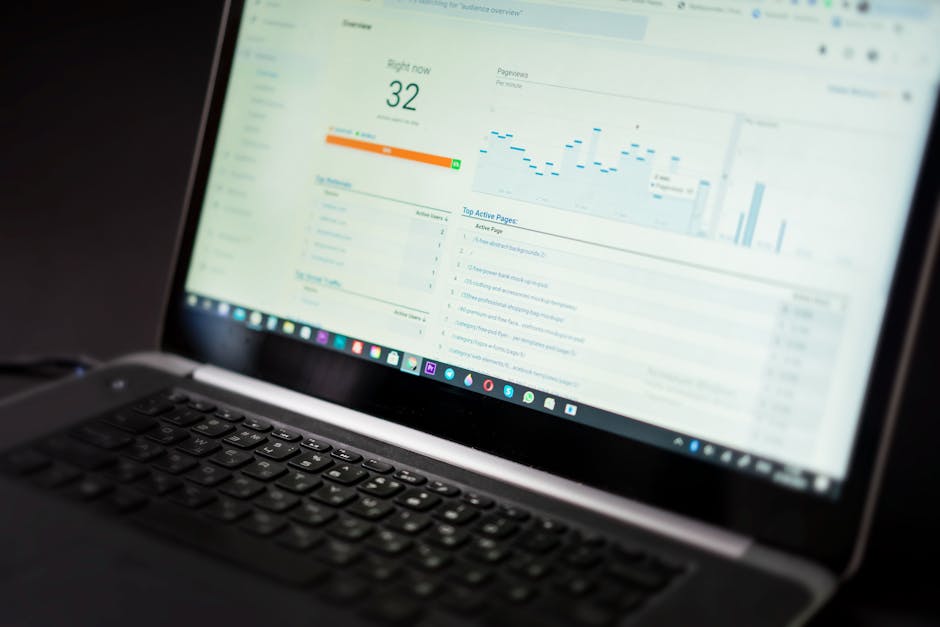KPI and Dashboard: Top 5 Powerful Insights 2025
KPI and dashboard: A dynamic duo that can transform how businesses operate and grow. For those new to this, here’s a quick lowdown:
- KPI (Key Performance Indicator): A measurable metric that indicates how well a company meets its strategic goals.
- Dashboard: A visual tool that collates and presents KPIs in real-time, often using charts and graphs for easier understanding.
- Business Intelligence: The process of using technology and data to support better business decision-making.
KPI dashboards are essential tools that help businesses visualize data and convert it into actionable insights. By clearly displaying KPIs, they provide a snapshot of business health, aiding in swift and data-driven decision-making. This makes them invaluable for anyone looking to steer their business with clarity and strategy.
I’m Russell Rosario. With my background in accounting, financial management, and software engineering, I’ve helped many businesses streamline their kpi and dashboard strategies. Let’s dive deeper into how these tools can revolutionize your business intelligence approach.

Kpi and dashboard terms made easy:
– free kpi dashboard software
– kpi dashboard open source software
– kpi tracking software
Understanding KPI Dashboards
KPI dashboards are powerful visual tools that transform raw data into digestible insights. They focus on key performance indicators, or KPIs, which are specific metrics that reflect how well an organization is achieving its objectives. These dashboards present data in a clear, visual format using charts, graphs, and tables to make complex information easy to understand at a glance.
Visual Tools:
Dashboards are designed to be user-friendly. They use visual elements to present data, enabling users to quickly grasp trends and patterns. Imagine a dashboard as a car’s dashboard; it provides instant updates on speed, fuel level, and engine status. Similarly, a KPI dashboard gives a real-time overview of business performance. For example, a sales dashboard might display a line graph showing monthly sales growth or a pie chart illustrating market share distribution.
Key Performance Indicators:
KPIs are the heart of any dashboard. They are carefully selected metrics that align with strategic goals. A well-chosen KPI provides meaningful insights and drives action. For instance, if a business aims to boost customer satisfaction, relevant KPIs might include customer feedback scores and average response time. The key is to focus on 5-10 KPIs to avoid information overload and maintain clarity.

Data Sources:
For a dashboard to be effective, it must pull accurate data from reliable sources. This could include data from CRM systems, financial software, or marketing tools. Ensuring data compatibility and accuracy is crucial. Tools like Improvado can help sync data from various sources, providing a seamless and up-to-date view of performance metrics.
In summary, KPI dashboards are essential for visualizing data and driving informed decision-making. By focusing on relevant KPIs and using reliable data sources, businesses can harness these tools to gain clear insights and achieve their strategic goals.
Next, we’ll explore the benefits of KPI dashboards and how they can improve executive decision-making, operational efficiency, and collaboration.
Benefits of KPI Dashboards
KPI dashboards are not just about pretty charts; they are strategic tools that can transform how a business operates. Here’s how:
Executive Decision-Making
For executives, having a KPI dashboard is like having a control panel for the entire organization. It provides a unified view of all critical metrics in real time. This means decisions can be made quickly and based on the most current data. According to the KPI Institute, 68% of businesses report improved performance when using dashboards. This is because executives can instantly see what’s working and what’s not, allowing them to pivot strategies without waiting for monthly reports.
Operational Efficiency
KPI dashboards streamline operations by eliminating data silos. They provide a single source of truth, making it easier for teams to access the information they need without the back-and-forth of emails or meetings. For example, a marketing team can pull conversion rates directly from the dashboard, saving time and reducing errors. This operational efficiency means teams can focus more on strategic priorities rather than data collection and reporting.
Collaboration
A KPI dashboard fosters a culture of transparency and collaboration. With everyone looking at the same data, it’s easier to align goals and work together towards common objectives. This shared visibility accelerates communication and fosters teamwork. As noted in the research, having a shared KPI dashboard democratizes data, leading to better team alignment and happier employees.
KPI dashboards are indispensable for modern businesses. They improve executive decision-making, boost operational efficiency, and promote collaboration across teams. Next, we’ll dive into how to create a KPI dashboard that meets your specific needs.
How to Create a KPI Dashboard
Creating a KPI dashboard is like piecing together a puzzle. Each part, from choosing the right KPIs to selecting data sources and visualizing the data, must fit perfectly to give you a clear picture of your business performance. Here’s how to get started:
Choose KPIs
The first step is to select the key performance indicators that align with your business goals. Think about what you want to achieve and which metrics will help you measure success.
- Focus on 5-10 KPIs to avoid information overload. This way, you ensure clarity and focus on the most important metrics.
- Assign a clear owner for each KPI, so there’s accountability for tracking and action.
- Use different KPIs for various departments. For example, a sales team might track revenue growth, while a customer service team might focus on customer satisfaction scores.
Select Data Sources
Once you’ve chosen your KPIs, identify where your data will come from. This step is crucial for ensuring that your KPI dashboard provides accurate and timely information.
- List all necessary data sources. These could include CRM systems, financial software, or marketing tools.
- Ensure data compatibility across systems. This means checking that data formats align and can be integrated smoothly.
- Use tools like Improvado to automatically sync data and maintain data integrity.
Visualize Data
The final step is to design your dashboard in a way that presents data clearly and effectively. Visualization helps users quickly understand complex data.
- Keep it simple and visually consistent. Use charts, graphs, and tables to make data easy to digest.
- Group related metrics together to provide context and avoid confusion.
- Add interactive elements like filters and clickable charts. This allows users to drill down into the data for deeper insights.
By carefully choosing KPIs, selecting the right data sources, and designing a clear and interactive dashboard, you create a tool that not only tracks performance but also drives action.
In the next section, we’ll explore best practices to ensure your KPI dashboard is as effective as possible.
Best Practices for KPI Dashboards
Creating a KPI dashboard is just the beginning. To make sure it works for you, follow these best practices. They focus on visual consistency, simplicity, and clean data.
Visual Consistency
Consistency is key when designing a dashboard. It helps users quickly understand the data without getting confused.
- Use a limited color palette. Stick to two or three colors. For example, use green for positive trends and red for negative ones. This makes it easy to spot changes at a glance.
- Maintain uniform fonts and sizes. This ensures that your dashboard looks professional and is easy to read.
- Align elements neatly. Make sure charts, graphs, and tables are aligned. It creates a tidy and organized look, helping users focus on the data.
Simplicity
A simple dashboard is a powerful tool. It allows users to find the information they need without getting overwhelmed.
- Limit the number of KPIs. Aim for 5-10 KPIs. This prevents information overload and keeps the focus on what’s most important.
- Avoid clutter. Remove unnecessary elements that don’t add value. Stick to the essentials to keep the dashboard clean and effective.
- Use clear labels and legends. Simple text helps users understand what they’re looking at right away.
Clean Data
Your dashboard is only as good as the data it displays. Ensure your data is accurate and up-to-date.
- Verify data accuracy. Regularly check your data sources for errors. Incorrect data can lead to poor decision-making.
- Automate data updates. Set up automatic synchronization to keep your dashboard current. This reduces the risk of outdated information.
- Test data reliability. Before launching the dashboard, test it to make sure the data is reliable and consistent.
By following these best practices, you’ll create a KPI dashboard that is not only visually appealing but also a valuable tool for making informed decisions.
Next, we’ll address some frequently asked questions about KPI dashboards to further improve your understanding.
Frequently Asked Questions about KPI and Dashboard
How many KPIs should be on a dashboard?
When it comes to KPI dashboards, less is often more. Including too many KPIs can lead to information overload, making it hard for users to focus on what’s important. Aim for 5-10 KPIs. This ensures clarity and allows users to quickly grasp the most crucial insights.
A focused dashboard helps in making quick, informed decisions. It keeps users engaged and prevents them from feeling overwhelmed by too much data.
What is the difference between a KPI Dashboard and a KPI Report?
A KPI dashboard and a KPI report serve different purposes and offer different insights.
KPI Dashboards provide real-time data. They are dynamic and interactive, showing how your business is performing at any given moment. Think of them like a car’s dashboard, giving you live feedback on speed and fuel levels.
On the other hand, KPI Reports are more static. They focus on historical analysis, compiling data over specific periods to offer a comprehensive review of past performance. These reports are detailed, with narrative explanations and recommendations. They are typically presented as documents, like PDFs, and are used for strategic planning and stakeholder reporting.
How can I ensure the security of data within a KPI dashboard?
Data security is crucial when dealing with KPI dashboards. Here are some key practices to ensure your data stays safe:
-
Data Encryption: This transforms data into a coded form that only authorized parties can read. It’s like locking your data in a safe that only you have the key to.
-
Access Control: Set up strict access policies to ensure that only authorized users can view or modify the dashboard. This is like having a bouncer at the door, checking IDs before letting anyone in.
-
Regular Testing and Review: Conduct regular security tests to identify vulnerabilities. This helps ensure that the dashboard remains secure over time.
By focusing on these security measures, you can protect sensitive data and maintain user trust.
Next, we’ll dive into the conclusion and explore how Profit Leap can help you leverage these insights for better business decisions.
Conclusion
At Profit Leap, we understand the transformative potential of KPI dashboards. Our approach is simple: turn complex data into actionable insights that empower your business to make smarter decisions.
Our unique selling point? Huxley, the first AI business advisor designed specifically for small business owners. Huxley goes beyond traditional dashboards by offering predictive analytics and intelligent recommendations. This means you’re not just reacting to data; you’re shaping your business strategy based on robust, data-driven insights.
Imagine reducing your accounting time from over 21 hours a week to just a few hours. With Huxley, you gain the freedom to focus on growing your business while our AI handles the heavy lifting.
Custom Insights Custom for You
We don’t believe in one-size-fits-all solutions. Our KPI dashboards are crafted to reflect the unique aspects of your business. We ensure that the metrics displayed are relevant and provide a real-time view of your operations. This means you can make informed decisions quickly, without wading through irrelevant data.
Consider the story of Michael Solis from TransRide. His business struggled with unprofitable operations due to a lack of clear forecasting. After implementing our solutions, his business turned around in just a couple of months. This is the kind of impact Profit Leap can have on your business.
Find how our KPI Dashboard Software can revolutionize your business intelligence strategy.
Together, let’s harness the full potential of your data to drive growth and innovation.


